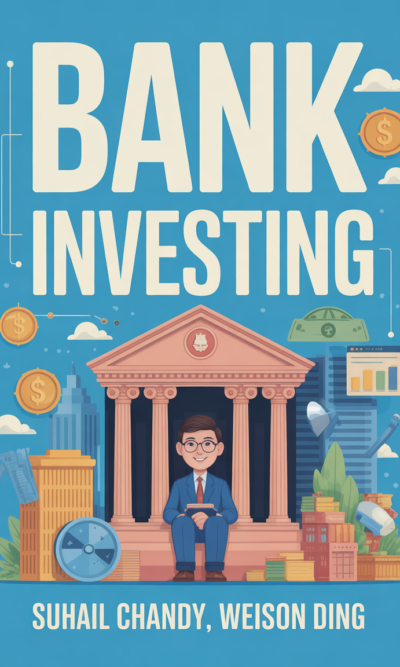Description
Money and markets can often feel like a puzzle. Every day, numbers move on screens, experts argue on television, and people around the world place their savings into stocks, bonds, and funds. But beneath all the noise, there is a simple question: why do we invest at all? The answer lies not only in wealth but also in security, opportunity, and the chance to build a meaningful future.
In today’s world, technology is reshaping everything. Robots, artificial intelligence, and automation are taking over jobs once done by people. For many, this shift creates deep anxiety. Work that once gave people stability and dignity now feels fragile. As machines get better at tasks once thought safe from automation—like design, writing, or even legal work—there seems to be fewer places where humans have an advantage. Out of this fear, a new kind of investing has grown. Instead of investing purely to grow wealth, people now invest defensively. They put money into the very technologies that threaten traditional jobs, believing that owning a share in the disruption is the only way to remain relevant. Technology stocks have become lifelines, not just opportunities. This reflects a big change: people are no longer investing only for retirement or growth, but as a shield against being left behind.
Alongside this shift is another important trend: investing has become more passive. Decades ago, brokers earned commissions on every trade, so activity was constant. But over time, major firms moved to fee-based accounts, where they charge based on assets managed rather than trades executed. This small change in structure has reshaped the entire market. Instead of chasing quick wins through constant buying and selling, more money is now placed into long-term strategies like index funds and mutual funds. These approaches are calmer, steadier, and often more profitable over time. The result? Markets now behave differently. Dips are quickly met with buying, because steady investment flows keep pouring in. The ups and downs still exist, but recovery comes faster, and long-term growth remains the central pattern. Passive investing has created a market that tends to rise, as fewer people rush to sell and more choose to hold.
Emotions, however, still play a massive role. Throughout history, greed and fear have moved markets. But in the modern world, those emotions often show up as insecurity and envy. Social media has amplified these feelings. Seeing others make huge gains in cryptocurrencies or technology stocks can leave people feeling inadequate or excluded. The “fear of missing out” has become a powerful driver, pushing individuals into investments they barely understand, just to avoid being left behind. At the same time, envy fuels unhealthy competition. People don’t just want to succeed—they want their success to be seen and compared to others. This creates risky behavior, where decisions are based less on logic and more on emotion. The market, in many ways, has become a mirror of human psychology, where visibility and validation push people to take dangerous bets.
With so much complexity in the world, many investors are tempted by strategies that seem clever or sophisticated. But history shows that simplicity works better. Complicated investment schemes often hide hidden risks, and even experts fall for them. One well-known example was the collapse of a once-promising energy company, where many professional investors were lured into a web of complexity they thought they understood—until it all fell apart. The lesson is clear: simple strategies, based on transparency and common sense, often outperform the most complicated plans. Great investors often repeat the same wisdom: avoid what you cannot explain clearly, stick to what you understand, and focus on fundamentals. Complexity may look impressive, but simplicity is usually stronger.
Another lesson lies in how to read the markets themselves. While economic reports and company news matter, at the end of the day, prices tell the real story. In times of stress, everyone—whether professional or beginner—watches the same thing: price movements. If a stock goes up, people see success. If it goes down, doubts spread quickly. This cycle of confidence and fear is captured in prices, which serve as the clearest signal of how investors feel. Many believe that prices even shape the news itself: good prices create good stories, and bad prices create bad ones.
This perspective, sometimes called “technical thinking,” is based on patterns and trends. It assumes that history leaves clues, and past prices create levels of support and resistance that influence future behavior. Investors often buy when a stock falls to a previous low, or sell when it reaches a past high. These habits form self-fulfilling patterns, because enough people believe in them. Watching price action is a way of staying grounded in the reality of the market—what people are actually doing—rather than in abstract forecasts.
So, what does all this mean for someone trying to invest wisely today? The lessons come together in a simple way. First, recognize the world is changing, and technology will continue to reshape jobs, industries, and opportunities. Owning a piece of this transformation can help protect against being left out. Second, understand that passive investing is powerful. Putting money into broad funds, holding for the long term, and avoiding constant trading gives stability and steady growth. Third, keep emotions in check. Fear, insecurity, and envy are dangerous guides. Investing should be about your goals, not about competing with others. Fourth, embrace simplicity. If you cannot explain an investment in plain words, it may not be worth your time. And finally, respect price signals. The market is always speaking through prices, and those movements reflect the collective wisdom and emotions of millions of investors.
The truth is, investing does not have to be complicated. It requires discipline, patience, and awareness of both human behavior and technological change. By keeping strategies simple, focusing on the long term, and resisting emotional impulses, investors can navigate the uncertainty of the market and build a future that feels secure. Wealth, after all, is not just about numbers on a screen. It is about freedom, opportunity, and the ability to face the future with confidence.





